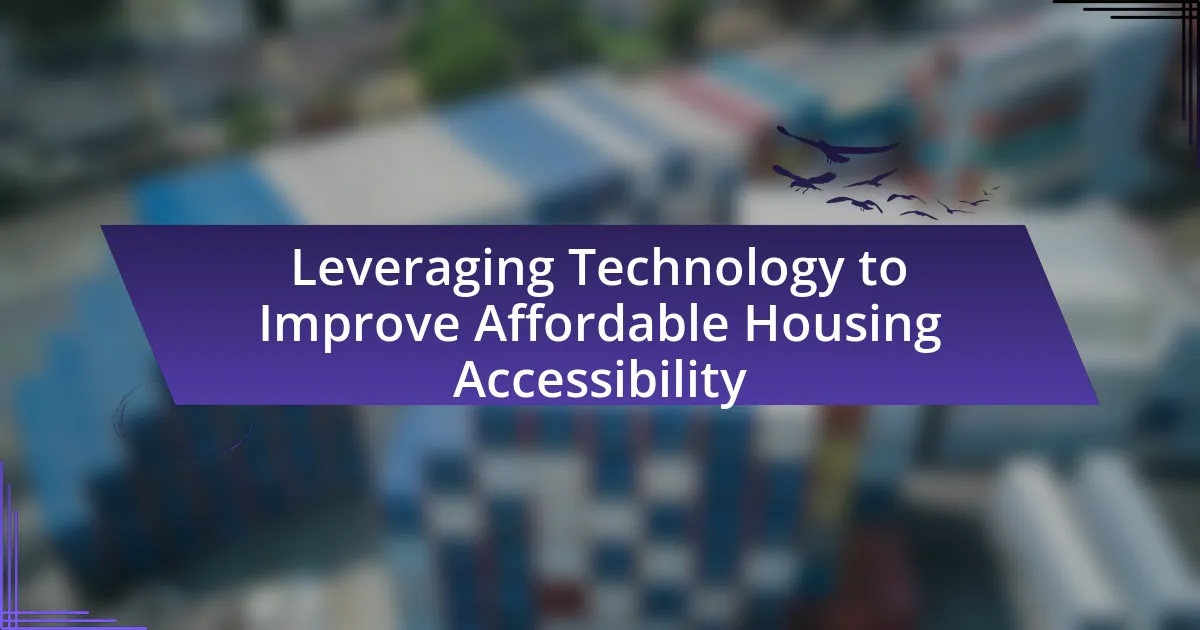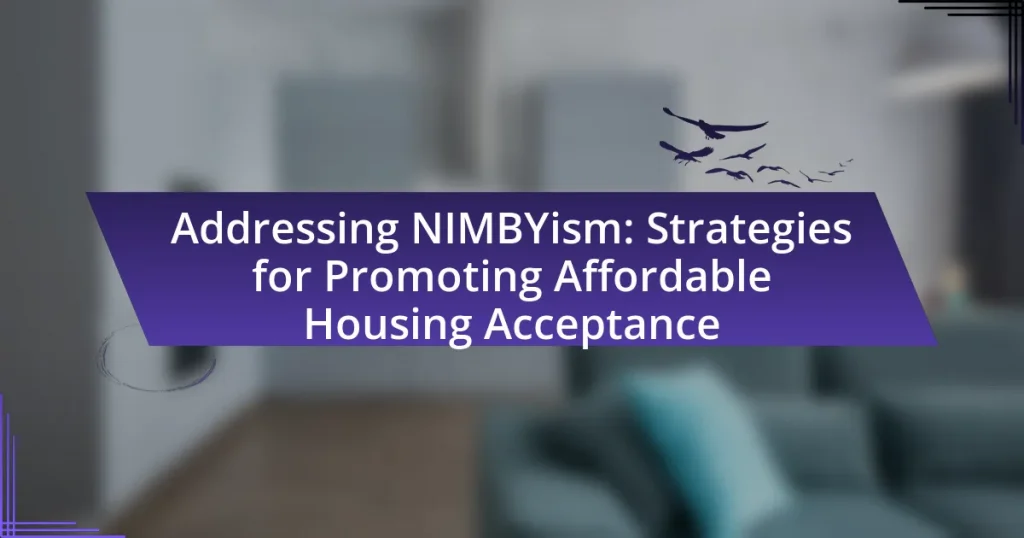Leveraging technology to improve affordable housing accessibility focuses on utilizing digital tools and innovative construction methods to enhance housing options for low-income individuals and families. Key technologies discussed include online platforms for housing searches, data analytics for resource allocation, and advanced construction techniques like modular construction and 3D printing, which can significantly reduce costs. The article also addresses challenges such as high initial costs, regulatory barriers, and the need for skilled labor, while highlighting the social impacts of improved housing access and future trends in technology adoption. Overall, the integration of technology is positioned as a crucial factor in making affordable housing more accessible and sustainable.
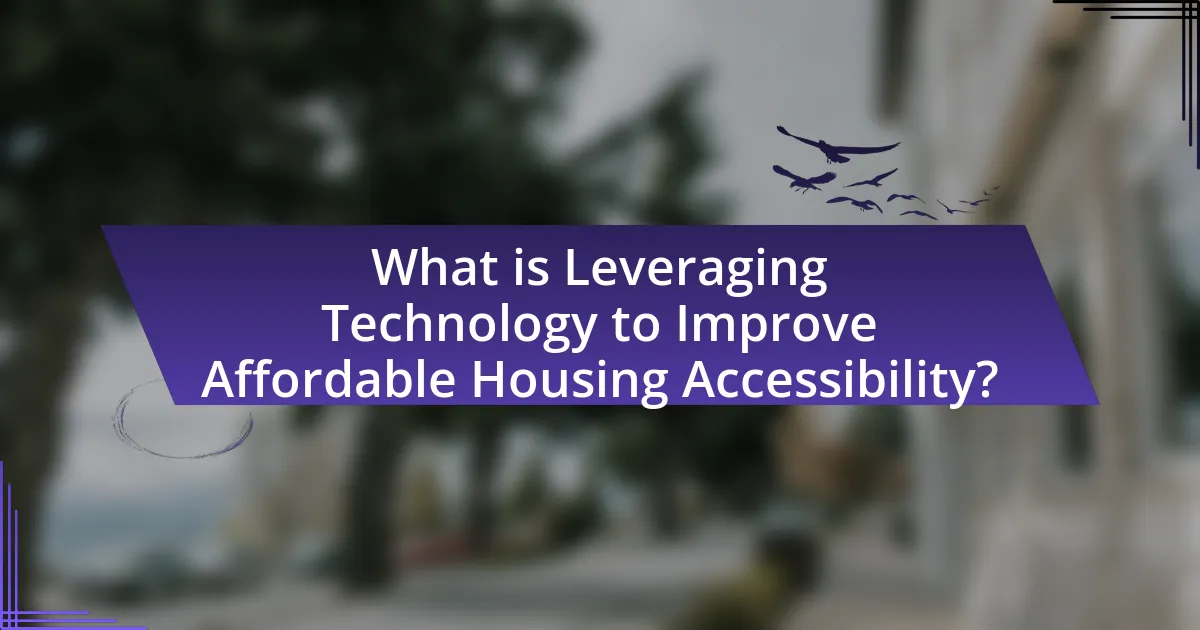
What is Leveraging Technology to Improve Affordable Housing Accessibility?
Leveraging technology to improve affordable housing accessibility involves utilizing digital tools and innovative solutions to enhance the availability and affordability of housing options for low-income individuals and families. For instance, platforms that connect renters with affordable housing listings streamline the search process, while data analytics can identify areas in need of development, ensuring resources are allocated effectively. Additionally, technologies such as 3D printing and modular construction can significantly reduce building costs, making it easier to create affordable housing units. According to a report by the Urban Institute, the integration of technology in housing development can lead to a 20-30% reduction in construction costs, thereby increasing the accessibility of affordable housing.
How does technology play a role in affordable housing accessibility?
Technology enhances affordable housing accessibility by streamlining processes, improving communication, and utilizing data analytics. For instance, online platforms facilitate the search for affordable housing options, allowing users to filter listings based on their financial capabilities and preferences. Additionally, technologies such as Geographic Information Systems (GIS) enable policymakers to identify areas with the greatest need for affordable housing, ensuring resources are allocated effectively. A report by the Urban Institute highlights that digital tools can reduce the time and costs associated with housing applications, making it easier for low-income families to secure housing.
What types of technology are being utilized in affordable housing?
Affordable housing utilizes various technologies, including modular construction, 3D printing, smart home systems, and energy-efficient building materials. Modular construction allows for faster assembly and reduced costs by prefabricating sections of homes off-site. 3D printing technology can create housing structures at a fraction of traditional costs, with some projects demonstrating the ability to produce homes in less than 24 hours. Smart home systems enhance energy efficiency and security, making homes more sustainable and affordable to maintain. Energy-efficient building materials, such as insulated panels and solar panels, contribute to lower utility costs, further improving affordability for residents.
How does technology enhance the design and construction of affordable housing?
Technology enhances the design and construction of affordable housing by streamlining processes, reducing costs, and improving efficiency. For instance, Building Information Modeling (BIM) allows architects and builders to create detailed digital representations of structures, facilitating better planning and collaboration. This technology can reduce construction time by up to 30%, as reported by the National Institute of Building Sciences. Additionally, modular construction techniques enable off-site fabrication of housing components, which can lower labor costs and minimize waste. According to a study by McKinsey & Company, adopting advanced construction technologies can lead to cost savings of 20% to 30% in housing projects. These advancements collectively contribute to making affordable housing more accessible and sustainable.
What challenges exist in leveraging technology for affordable housing?
The challenges in leveraging technology for affordable housing include high initial costs, lack of infrastructure, and regulatory barriers. High initial costs can deter developers from adopting innovative technologies, as they may require significant upfront investment. Additionally, inadequate infrastructure in certain regions limits the implementation of advanced technologies, making it difficult to integrate smart solutions into housing projects. Regulatory barriers, such as zoning laws and building codes, can hinder the adoption of new technologies, as they may not accommodate innovative construction methods or materials. These challenges collectively impede the effective use of technology in creating affordable housing solutions.
What are the barriers to technology adoption in the housing sector?
The barriers to technology adoption in the housing sector include high costs, lack of skilled workforce, resistance to change, and regulatory challenges. High costs deter investment in new technologies, as many housing developers and organizations operate on tight budgets. The lack of a skilled workforce limits the ability to implement and maintain advanced technologies, which is critical for successful adoption. Resistance to change often stems from established practices and skepticism about the benefits of new technologies. Regulatory challenges can create additional hurdles, as outdated regulations may not accommodate innovative solutions, hindering their integration into existing housing frameworks.
How do regulatory frameworks impact technology use in affordable housing?
Regulatory frameworks significantly influence technology use in affordable housing by establishing guidelines that dictate how technologies can be implemented and integrated. These frameworks can either facilitate or hinder innovation; for instance, regulations that promote energy efficiency standards encourage the adoption of smart technologies, such as energy management systems, which can reduce operational costs and improve sustainability. Conversely, overly restrictive regulations may limit the deployment of new technologies, such as modular construction methods, which have been shown to reduce building costs and timeframes. Evidence from the U.S. Department of Housing and Urban Development indicates that supportive regulatory environments can lead to increased investment in technology-driven solutions, ultimately enhancing the accessibility and quality of affordable housing.
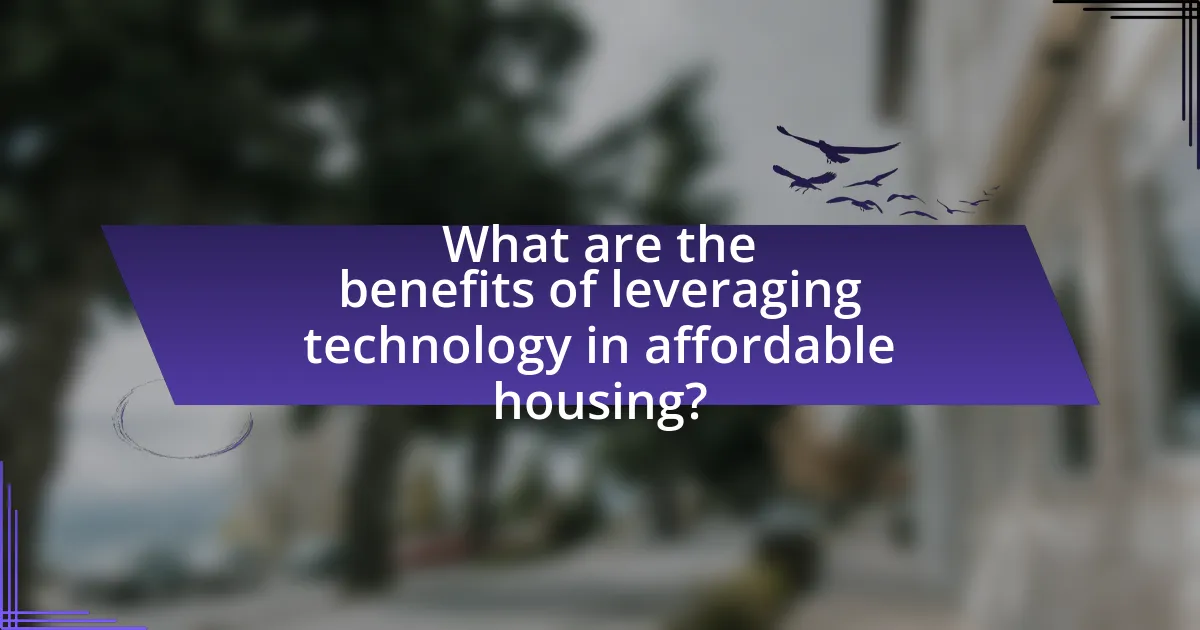
What are the benefits of leveraging technology in affordable housing?
Leveraging technology in affordable housing enhances efficiency, reduces costs, and improves accessibility. For instance, the use of digital platforms for property management streamlines operations, allowing for quicker response times to tenant needs and maintenance requests. Additionally, technologies like 3D printing and modular construction can significantly lower building costs and construction time, making housing more affordable. A report by McKinsey & Company highlights that adopting advanced construction technologies can reduce project costs by up to 20%. Furthermore, smart home technologies can increase energy efficiency, leading to lower utility bills for residents, thereby making housing more sustainable and affordable in the long term.
How does technology improve the efficiency of affordable housing projects?
Technology enhances the efficiency of affordable housing projects by streamlining design, construction, and management processes. For instance, Building Information Modeling (BIM) allows for precise planning and visualization, reducing errors and rework during construction. Additionally, modular construction techniques enable faster assembly of housing units, which can decrease labor costs and project timelines. A study by McKinsey & Company found that digitizing construction processes can lead to productivity improvements of 15-20%. Furthermore, smart technologies in energy management can lower operational costs, making housing more affordable in the long run.
What cost savings can be achieved through technology in housing?
Technology in housing can achieve significant cost savings through automation, energy efficiency, and data analytics. Automation reduces labor costs by streamlining construction processes, as seen in modular and prefabricated housing, which can cut construction time by up to 50%. Energy-efficient technologies, such as smart thermostats and solar panels, lower utility bills, with studies indicating potential savings of 30% on energy costs. Data analytics enhances decision-making in property management, optimizing maintenance schedules and reducing operational expenses by up to 20%. These technologies collectively contribute to lower overall housing costs, making affordable housing more accessible.
How does technology enhance the quality of living in affordable housing?
Technology enhances the quality of living in affordable housing by integrating smart home features, energy-efficient systems, and improved communication tools. Smart home technologies, such as automated lighting and heating, allow residents to control their environments more efficiently, leading to reduced energy costs and increased comfort. Energy-efficient appliances and building materials contribute to lower utility bills and a smaller carbon footprint, which is crucial for low-income households. Additionally, technology facilitates better communication between residents and property management through mobile apps, enabling quicker responses to maintenance requests and fostering a sense of community. Studies indicate that these technological advancements can lead to a 20-30% reduction in energy consumption, significantly benefiting residents in affordable housing.
What social impacts arise from improved accessibility to affordable housing through technology?
Improved accessibility to affordable housing through technology leads to enhanced social equity and community stability. By utilizing platforms that streamline the housing search process, marginalized groups gain better access to housing options, reducing disparities in housing availability. For instance, a study by the Urban Institute found that technology-driven initiatives can increase housing search efficiency by up to 30%, allowing lower-income families to secure homes more quickly. This increased access fosters diverse communities and promotes social cohesion, as individuals from various backgrounds can live in closer proximity, enhancing social networks and support systems.
How does technology contribute to community development?
Technology contributes to community development by enhancing communication, improving access to resources, and facilitating collaboration among community members. For instance, digital platforms enable residents to share information about housing opportunities, local services, and community events, fostering a sense of belonging and engagement. Additionally, technologies such as Geographic Information Systems (GIS) allow for better urban planning and resource allocation, ensuring that affordable housing projects are strategically located to meet community needs. According to a report by the World Bank, the use of technology in urban planning can lead to more efficient land use and improved living conditions, ultimately supporting sustainable community development.
What role does technology play in reducing homelessness?
Technology plays a crucial role in reducing homelessness by enhancing access to resources, streamlining services, and improving data collection. For instance, mobile applications connect individuals experiencing homelessness with shelters, food services, and job opportunities, facilitating immediate assistance. Additionally, data analytics helps organizations identify trends and allocate resources more effectively, as seen in cities like Los Angeles, where data-driven approaches have led to a 20% reduction in homelessness over five years. Furthermore, online platforms enable crowdfunding for housing initiatives, allowing communities to mobilize financial support for affordable housing projects. These technological advancements create a more efficient system for addressing homelessness and improving overall housing accessibility.
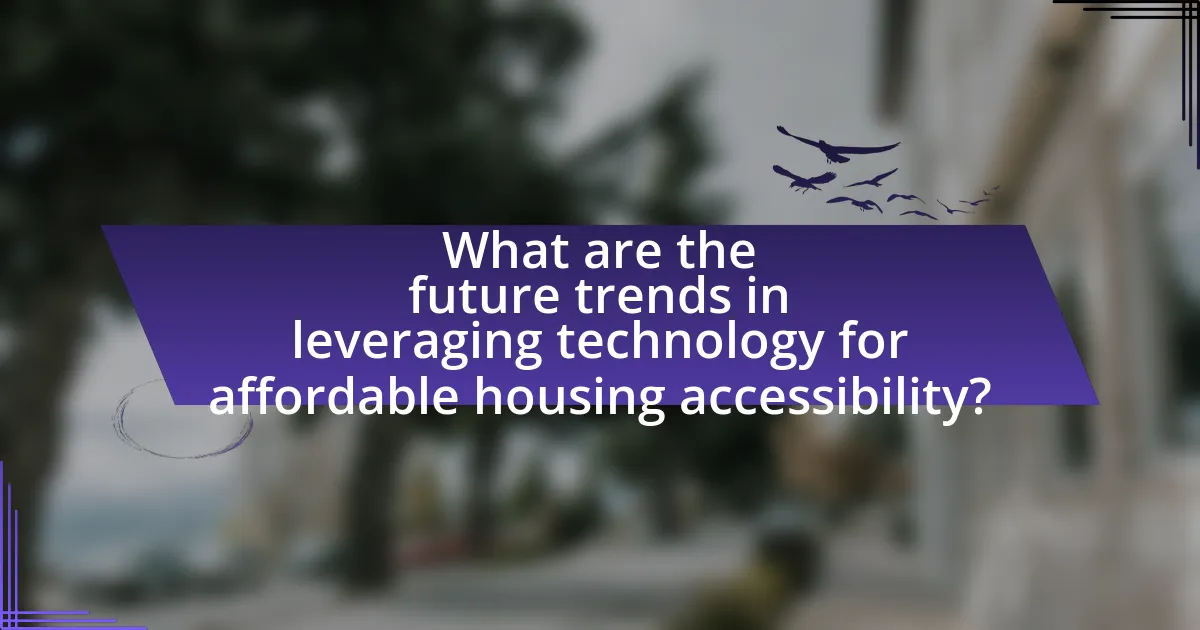
What are the future trends in leveraging technology for affordable housing accessibility?
Future trends in leveraging technology for affordable housing accessibility include the increased use of artificial intelligence (AI) for predictive analytics in housing demand, the integration of blockchain for transparent property transactions, and the application of virtual reality (VR) for remote property viewing. AI can analyze demographic data and economic indicators to forecast housing needs, enabling developers to build in areas with the highest demand. Blockchain technology enhances trust and efficiency in transactions by providing a secure, immutable record of property ownership and history, which can reduce fraud and lower costs. Additionally, VR allows potential buyers or renters to explore properties remotely, making housing options more accessible to individuals who may have mobility issues or live in distant locations. These trends are supported by the growing adoption of smart technologies in urban planning and housing development, as evidenced by initiatives in cities like San Francisco and Amsterdam, which are utilizing these technologies to address housing shortages and improve accessibility.
How is data analytics shaping the future of affordable housing?
Data analytics is shaping the future of affordable housing by enabling data-driven decision-making that optimizes resource allocation and identifies housing needs. Through the analysis of demographic trends, income levels, and housing market dynamics, stakeholders can better understand where affordable housing is most needed. For instance, a report by the Urban Institute highlights that data analytics can reveal patterns in housing demand and supply, allowing policymakers to target investments effectively. Additionally, predictive analytics can forecast future housing shortages, guiding the development of new projects in areas with the greatest need. This strategic use of data not only enhances the efficiency of affordable housing initiatives but also ensures that resources are directed to where they will have the most significant impact.
What innovations are emerging in smart housing solutions?
Innovations in smart housing solutions include the integration of Internet of Things (IoT) devices, energy-efficient systems, and advanced security features. IoT devices enable homeowners to control lighting, heating, and appliances remotely, enhancing convenience and energy management. Energy-efficient systems, such as smart thermostats and solar panels, reduce utility costs and environmental impact. Advanced security features, including smart locks and surveillance cameras, improve safety and provide real-time monitoring. According to a report by MarketsandMarkets, the smart home market is projected to reach $174 billion by 2025, indicating significant growth and adoption of these technologies.
How can virtual reality and augmented reality enhance housing accessibility?
Virtual reality (VR) and augmented reality (AR) can enhance housing accessibility by providing immersive experiences that allow potential buyers or renters to explore properties remotely. This technology enables individuals with mobility challenges to navigate homes virtually, eliminating the need for physical visits that may be difficult or impossible. For instance, a study by the National Association of Realtors found that 77% of homebuyers found virtual tours helpful in their search, indicating that VR and AR can significantly broaden access to housing options. Additionally, AR can assist in visualizing modifications for accessibility, such as wheelchair ramps or wider doorways, helping users make informed decisions about potential adaptations.
What best practices should be followed when implementing technology in affordable housing?
Best practices for implementing technology in affordable housing include ensuring community engagement, prioritizing user-friendly designs, and integrating sustainable solutions. Community engagement involves involving residents in the decision-making process to understand their needs and preferences, which can lead to higher satisfaction and better adoption rates. User-friendly designs are crucial, as technology must be accessible to all residents, including those with varying levels of digital literacy. Integrating sustainable solutions, such as energy-efficient systems and smart home technologies, can reduce long-term costs and improve living conditions. According to a report by the Urban Institute, projects that incorporate resident feedback and focus on usability tend to see a 30% increase in resident satisfaction and engagement.
How can stakeholders collaborate effectively to leverage technology?
Stakeholders can collaborate effectively to leverage technology by establishing clear communication channels and shared goals. This collaboration can be facilitated through regular meetings, joint workshops, and the use of collaborative platforms that allow for real-time information sharing. For instance, the National Association of Home Builders emphasizes the importance of partnerships among developers, government agencies, and technology providers to create innovative housing solutions. By aligning their objectives and utilizing technology such as data analytics and project management tools, stakeholders can streamline processes and enhance decision-making, ultimately improving affordable housing accessibility.
What are the key considerations for ensuring technology is accessible to all?
Key considerations for ensuring technology is accessible to all include usability, affordability, and compliance with accessibility standards. Usability involves designing technology that is intuitive and easy to navigate for individuals with varying abilities, ensuring that interfaces are user-friendly. Affordability ensures that technology is economically accessible to low-income populations, which is crucial in the context of affordable housing. Compliance with accessibility standards, such as the Web Content Accessibility Guidelines (WCAG), guarantees that digital content is perceivable, operable, and understandable for people with disabilities. These considerations are essential for creating an inclusive environment where technology serves everyone effectively.
